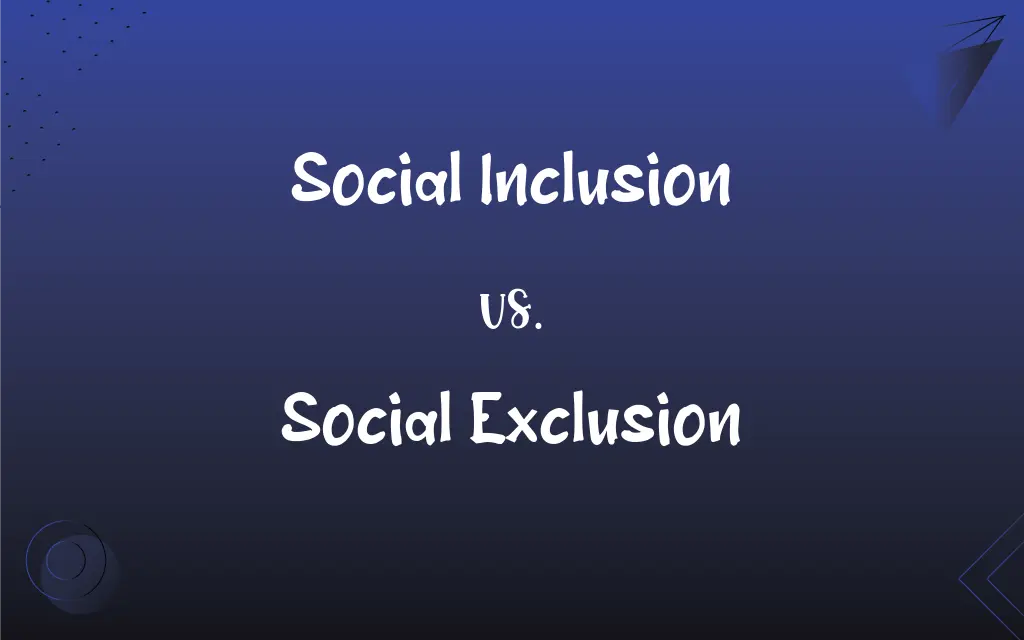Social Inclusion vs. Social Exclusion: What's the Difference?
Edited by Aimie Carlson || By Janet White || Published on December 11, 2023
Social inclusion is the process of improving the terms of participation in society for people who are disadvantaged, while social exclusion is the process by which individuals or groups are systematically blocked from rights, opportunities, and resources.

Key Differences
Social inclusion involves proactive measures to ensure all individuals have equal access to resources, opportunities, and rights, fostering a sense of belonging and empowerment. Conversely, social exclusion refers to the process where certain groups are systematically marginalized, preventing them from fully participating in societal, economic, and political life. Both concepts highlight disparities in societal participation.
Social inclusion aims to uplift individuals by integrating them into the fabric of society, enhancing their social, economic, and political participation. Social exclusion, in contrast, leads to individuals feeling isolated, disempowered, and unable to access necessary resources and opportunities, thus perpetuating cycles of poverty and marginalization.
From a policy perspective, social inclusion focuses on creating equitable and accessible systems for all, including marginalized groups. Social exclusion occurs when policies and practices create barriers that prevent specific groups from accessing these benefits, often leading to inequality and social stratification.
Economically, social inclusion involves strategies to ensure fair access to jobs, education, and wealth, aiming to reduce poverty and inequality. Social exclusion manifests in economic disparities, limited job opportunities, and restricted access to education and healthcare for marginalized groups.
In social dynamics, social inclusion promotes diversity, mutual respect, and equal participation in community life. In contrast, social exclusion leads to segregation, discrimination, and the erosion of social cohesion, often based on race, gender, disability, or socioeconomic status.
ADVERTISEMENT
Comparison Chart
Definition
Enhancing participation in society
Restricting participation in society
Impact on Individuals
Empowerment and integration
Marginalization and isolation
Policy Focus
Equitable access and opportunities
Barriers to access and opportunities
Economic Consequences
Reduced poverty and inequality
Increased poverty and inequality
Social Dynamics
Promotes diversity and respect
Leads to segregation and discrimination
ADVERTISEMENT
Social Inclusion and Social Exclusion Definitions
Social Inclusion
Social inclusion focuses on creating societal conditions where all can thrive and contribute.
Scholarships for underrepresented minorities are a form of social inclusion.
Social Exclusion
Social exclusion is the process of marginalizing individuals or groups from participating in social, economic, and political life.
Lack of disability access in buildings leads to social exclusion.
Social Inclusion
It refers to the opportunities and resources offered to people who might otherwise be excluded.
Providing sign language interpreters at events is an act of social inclusion for the deaf community.
Social Exclusion
It entails the segregation and isolation of individuals based on various factors like race, class, or disability.
Segregated neighborhoods exemplify social exclusion.
Social Inclusion
It means ensuring that all individuals have an active role and voice in society.
Town hall meetings that welcome feedback from all residents demonstrate social inclusion.
Social Exclusion
Social exclusion manifests in reduced access to education, healthcare, and employment for marginalized communities.
Inadequate public transportation in low-income areas is a barrier, leading to social exclusion.
Social Inclusion
Social inclusion is the process of improving participation in society for people from groups traditionally marginalized.
Implementing wheelchair ramps in public spaces is a step towards social inclusion.
Social Exclusion
It refers to the systemic denial of resources, rights, and opportunities to certain groups.
Gender-based pay disparities are a form of social exclusion.
Social Inclusion
Social inclusion is the practice of making all groups of people within a society feel valued and important.
A company's diversity hiring policy exemplifies social inclusion.
Social Exclusion
Social exclusion is the outcome of unequal power relationships within society.
Racial profiling by authorities is an instance of social exclusion.
FAQs
What is social inclusion?
Social inclusion is the process of improving participation and representation in society for marginalized or disadvantaged groups.
How does social inclusion benefit society?
It fosters diversity, reduces inequality, and promotes a healthier, more cohesive society.
Can social exclusion lead to social unrest?
Yes, as it can create feelings of resentment and inequality, potentially leading to conflict.
How can governments promote social inclusion?
Governments can implement policies that ensure equal opportunities, access to services, and anti-discrimination laws.
What role do education and healthcare play in social inclusion?
They are crucial for equipping individuals with the skills and health necessary to participate fully in society.
Can technology contribute to social inclusion?
Yes, by providing access to information and services, technology can help bridge gaps in society.
What does social exclusion mean?
Social exclusion refers to the systematic marginalization of certain groups, limiting their access to resources and opportunities.
Can social inclusion affect economic growth?
Yes, by integrating more people into the workforce and consumer base, social inclusion can spur economic growth.
What are common causes of social exclusion?
Factors like poverty, discrimination, and unequal policy implementation contribute to social exclusion.
How does social exclusion impact mental health?
It can lead to feelings of worthlessness, isolation, and increased risk of mental health issues.
How does social exclusion affect children and youth?
It can limit their opportunities for education and development, impacting their future prospects.
How does culture influence social inclusion and exclusion?
Cultural norms and values can either promote inclusivity or perpetuate exclusionary practices.
What are some signs of social exclusion in a community?
Signs include high unemployment rates among certain groups, segregated neighborhoods, and unequal access to education.
Is social inclusion only a government responsibility?
No, it also involves actions by communities, businesses, and individuals to create an inclusive environment.
What is the global impact of social inclusion?
It leads to more stable, equitable societies and better international relations and cooperation.
Can private companies play a role in social inclusion?
Yes, through inclusive hiring practices, corporate social responsibility, and accessibility in services and products.
What are some strategies to combat social exclusion?
Strategies include inclusive education policies, fair employment practices, and community integration programs.
How does social inclusion improve public services?
It ensures that public services cater to the diverse needs of the entire population.
What is the relationship between social inclusion and democracy?
A healthy democracy requires social inclusion to ensure that all voices are heard and represented.
Can social inclusion change over time?
Yes, as societies evolve, so do the dynamics of inclusion and exclusion, requiring ongoing effort and adaptation.
About Author
Written by
Janet WhiteJanet White has been an esteemed writer and blogger for Difference Wiki. Holding a Master's degree in Science and Medical Journalism from the prestigious Boston University, she has consistently demonstrated her expertise and passion for her field. When she's not immersed in her work, Janet relishes her time exercising, delving into a good book, and cherishing moments with friends and family.
Edited by
Aimie CarlsonAimie Carlson, holding a master's degree in English literature, is a fervent English language enthusiast. She lends her writing talents to Difference Wiki, a prominent website that specializes in comparisons, offering readers insightful analyses that both captivate and inform.






































































